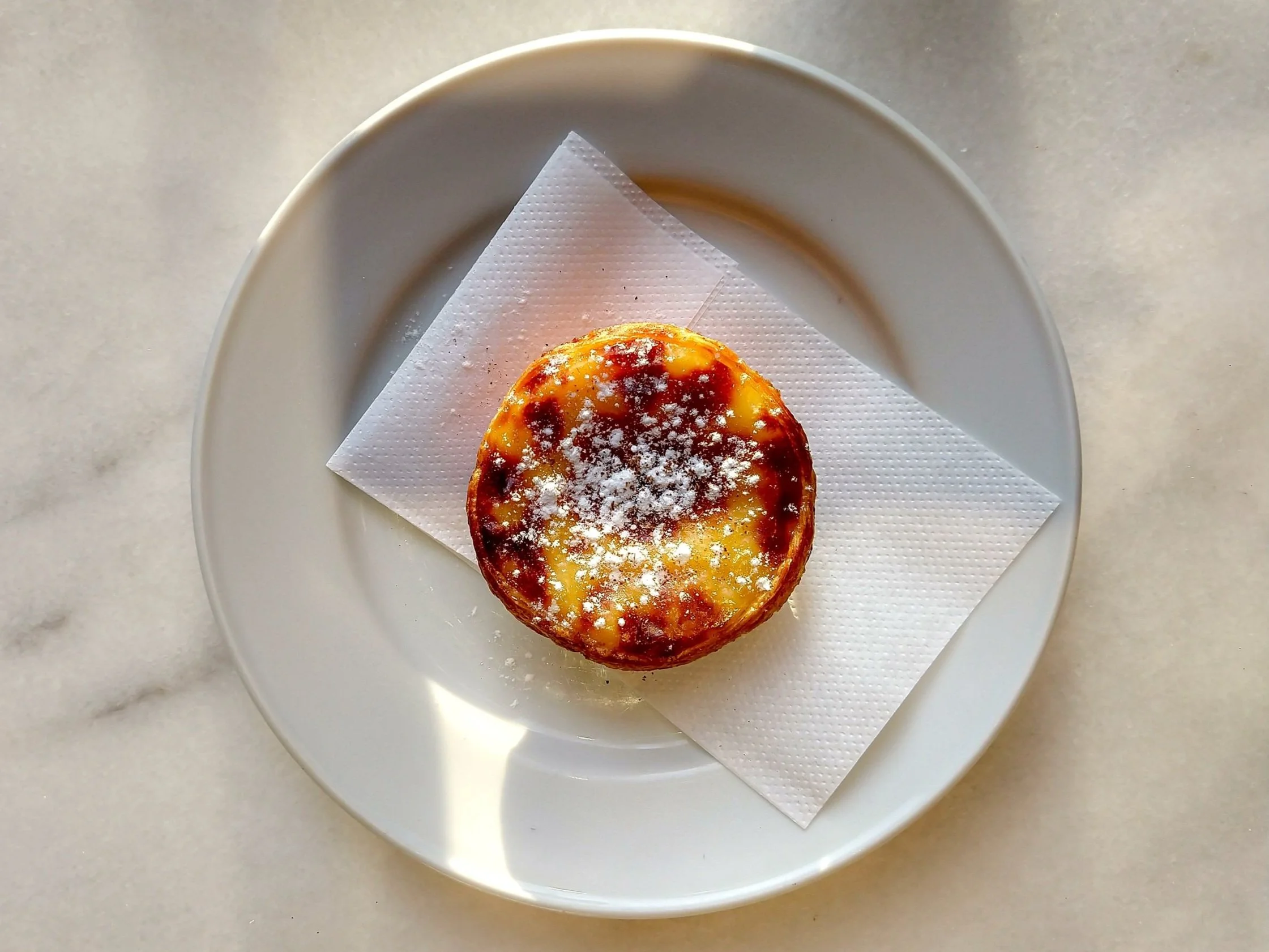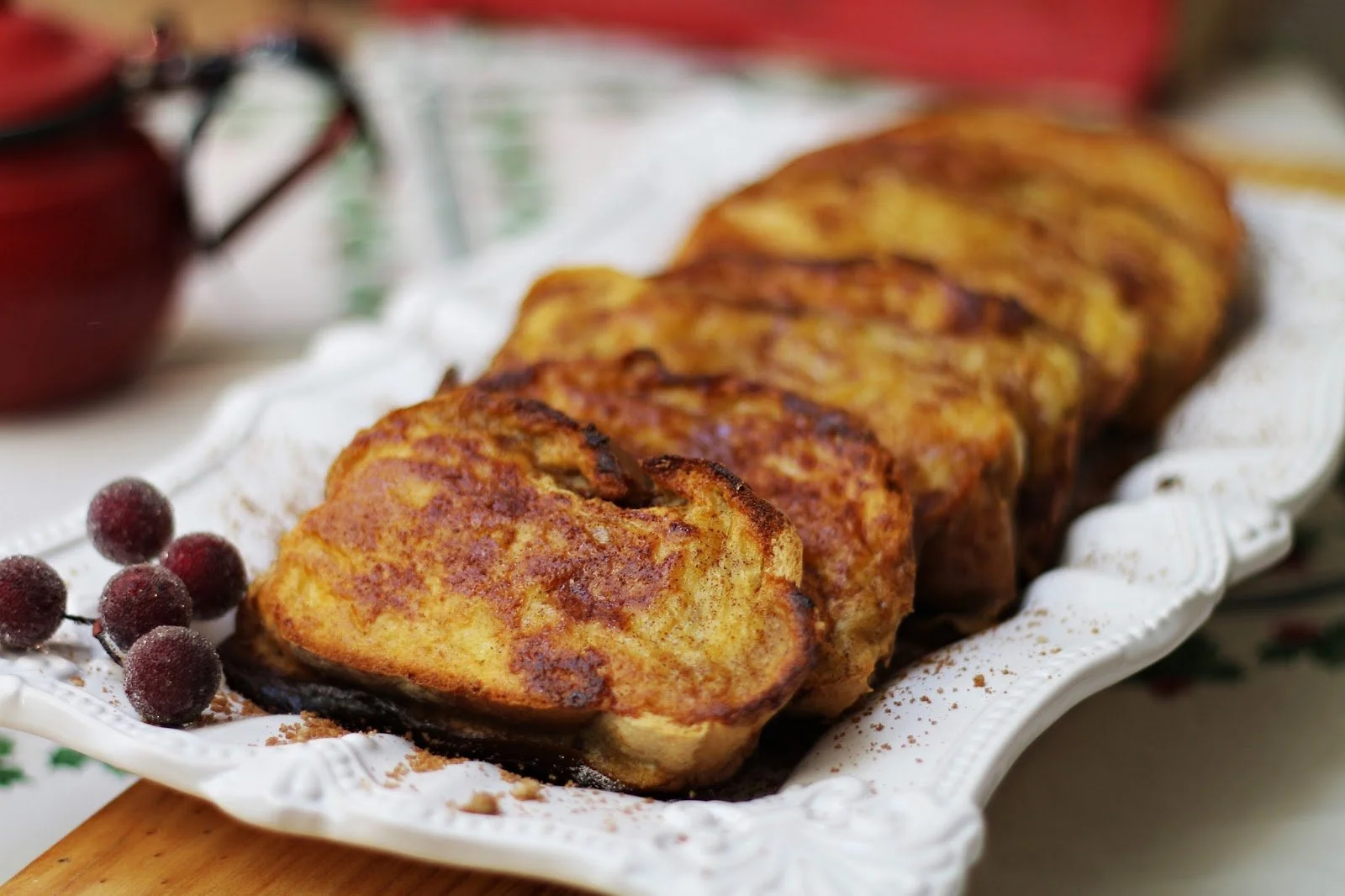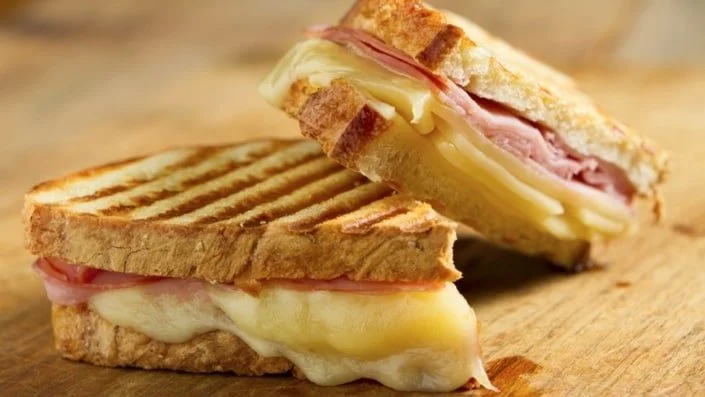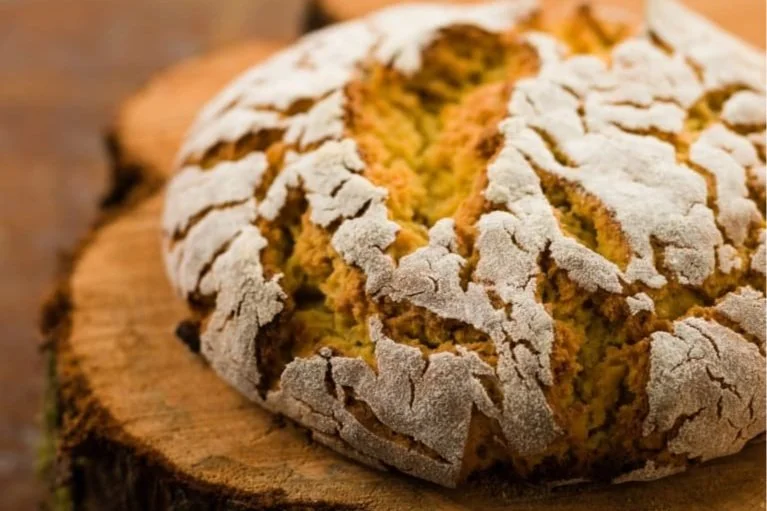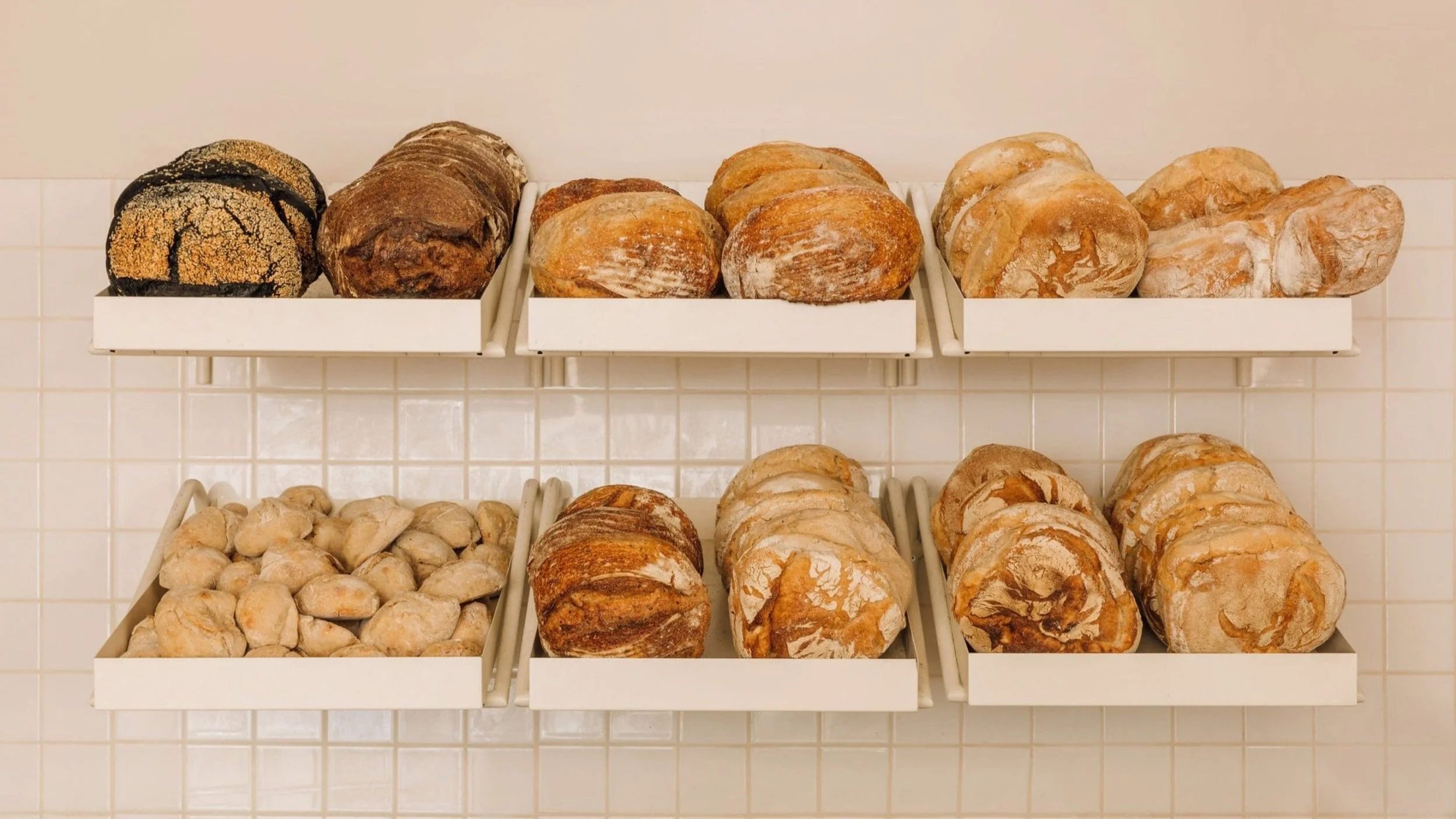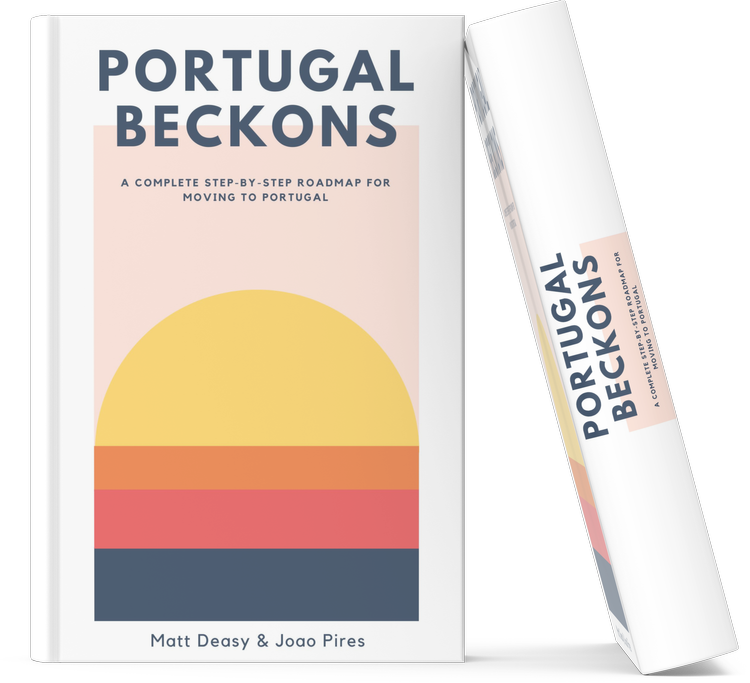Portuguese Breakfast: Savor the Start of the Day in Portugal
A Portuguese pastel de nata.
Wanna know more about Portugal and the Portuguese life? Download our “Portugal Beckons - Book”, read by over 700 expats.
Table of Contents
Portuguese Breakfast: Savor the Start of the Day in Portugal
Ever wondered what a Portuguese breakfast consists of?
Planning a trip to Portugal and curious as to whether you'll still be getting your daily bacon and eggs? (Spoiler: You can find bacon and eggs in restaurants and hotels catering for tourists, but not usually anywhere else).
Prepare to be tantalized by the unique flavors and traditions of a Portuguese breakfast. From the moment you take your first bite, you'll be transported to a world of culinary delights that reflect the rich cultural heritage of this vibrant country.
Breakfast holds great significance in Portuguese culture, and it's not just about satisfying hunger—it's an opportunity to connect with loved ones and start the day on a positive note. Unlike other cuisines, Portuguese breakfasts boast an array of mouthwatering options that will leave you craving for more.
A Portuguese breakfast is not always the healthiest, but the morning cakes are balanced out by the evening grilled fish and salad, so don't feel too guilty, and let's dive into the delectable world of Portuguese breakfast.
From freshly baked pastries like Pastel de Nata (custard tart) to my favourite tapas-for-breakfast, Presunto e Queijo, each bite tells a story. Join us as we unravel the secrets behind this morning feast that will leave your taste buds begging for another round.
What do the Portuguese Eat for Breakfast?
Typical Ingredients in a Portuguese Breakfast
Portuguese breakfasts are known for their simplicity and delicious flavors. The traditional morning meal in Portugal often consists of a variety of ingredients that make it both satisfying and enjoyable, sometimes in a coffee shop (café).
One of the key components of a traditional Portuguese breakfast is bread. Bread plays a significant role in Portuguese cuisine, and breakfast is no exception. You'll find various types of bread, such as pão de trigo (wheat bread) or pão de milho (cornbread), served during breakfast. These breads are usually enjoyed with butter, cheese, or jam, and, of course, Portuguese coffee.
Pastries also hold great importance in a traditional Portuguese breakfast. Pastéis de nata (custard tarts), custard tarts with flaky pastry shells, are an absolute delight and commonly consumed in the morning. Other popular pastries include Bola de Berlim (a cream-filled doughnut) and croissants filled with ham and cheese.
Traditional Portuguese Breakfast Dishes
Indulge in the iconic Pastel de Nata, a beloved custard tart from Portugal
The Pastel de Nata, also known as Portuguese custard tart or Portuguese egg tart, is a beloved treat that has a fascinating history dating back to the 18th century when Catholic monks at the Jerónimos Monastery in Belém, Lisbon, came up with a clever idea. With an excess of egg yolks from using egg whites to starch their clothes, they ingeniously incorporated them into a sweet pastry recipe. Little did they know that this creation would become an iconic symbol of Portuguese cuisine.
Pastéis de Nata (custar tart).
Experience the perfect harmony of flaky crust and creamy custard filling
When you take a bite of a Pastel de Nata, you'll be delighted by the contrasting textures. The crust is made from layers of thin puff pastry that is carefully rolled and folded, resulting in a flaky exterior that offers a satisfying crunch. Inside, the star of the show awaits – a velvety smooth custard filling. Made from rich cream, sugar, eggs, and vanilla extract, this custard is baked to perfection, achieving just the right consistency. The result is a creamy center that beautifully complements the buttery crust.
If you're seeking a delightful way to start your day, look no further than the iconic Pastel de Nata. This beloved Portuguese custard tart graces breakfast tables across the country and with its flaky pastry crust and luscious egg custard filling, it's no surprise that this treat has gained international acclaim.
Want some good news too? As far as cakes go, the Pastel de Nata is healthy (kinda), with around 300 calories per 100 grams, compared to 475 calories for caramel cake or 420 calories for a chocolate muffin, you can - at a stretch - convince yourself it's ok to have that extra one….
You can try making your own Pastel de Nata at home by preparing and rolling out a buttery puff pastry dough and fold it multiple times to achieve those signature layers. Once the pastry is ready, a rich and silky custard mixture made from eggs, sugar, cream, and vanilla is poured into each tart shell. The tarts are then baked until they turn a golden brown hue and finished with a sprinkle of cinnamon or powdered sugar for an extra touch of sweetness…. OR you could come to Portugal to experience the real thing. Much better.
Try Bola de Berlim, a delightful Portuguese donut filled with sweet goodness.
If your Pastel de Nata breakfast is a little too healthy, a Bola de Berlim will do the trick at ramping up your sugar and calorie intake, but it is soooo worth it.
A type of donut, hence the name, translates to "Berlin ball," which may seem perplexing at first glance. However, (and there are a few variations on this origin story) its roots can be traced back to World War II when Portuguese refugees who had fled to Berlin returned home with a newfound love for German pastries. To honor their time spent there, they decided to recreate these sweet treats with a local twist.
These round Portuguese donuts are similar to traditional American donuts but with their own unique twist. They are typically filled with sweet fillings such as jam or custard and dusted with powdered sugar, but can be incredibly versatile - here are some popular options you might come across:
Custard Cream: The classic filling that oozes decadence with every bite.
Chocolate: For all the chocoholics out there, this variation takes indulgence to another level.
Fruit Preserves: If you prefer a fruity burst, opt for Bola de Berlim filled with strawberry or raspberry preserves (jams to us Brits, jellies to you Americans!).
Nutella: Indulge your taste buds with the creamy goodness of Nutella spread inside these delightful donuts.
Vanilla Cream: For those who appreciate simplicity, vanilla cream offers a smooth and subtle flavor.
Bola de Berlin.
Experience Rabanadas, a unique twist on French toast that is popular during holidays
A beloved Portuguese breakfast dish that takes the concept of French toast to new heights, rabanadas are another must-try dish for any lover of Portuguese cuisine
Also, perhaps unsurprisingly, known as Portuguese-style toast, rabanadas are a popular treat during holidays, especially Christmas and similar to its European counterpart, rabanadas are made by soaking slices of bread in a mixture of eggs and milk before being fried until golden brown. However, what sets this Portuguese delicacy apart from other countries, is the unique combination of flavors and toppings that make it a true delight for breakfast enthusiasts.
Each different region of Portugal adds its own touch to cook this delectable treat, resulting in a diverse culinary experience. In Lisbon, for example, you'll often find Rabanadas dusted with cinnamon sugar or drizzled with honey. Meanwhile, in Porto, they take it up a notch by soaking the bread in Port wine before frying it to perfection, and in the Alentejo, locals add a savory twist to rabanadas by adding ham or cheese sandwiched between two slices of bread before being dipped in egg batter and frying.
To truly appreciate the uniqueness of Portuguese rabanadas, be sure to explore the popular regional variations and you can ignore the calories on account of ‘cultural research'!
Rabanadas.
Presunto e Queijo. Because Heaven should be experienced at all hours of the day
Now we're talking. Whereas most of the rest of the world limits their enjoyment of life by only having ham and cheese platters in the evening with a glass of wine, the Portuguese see no reason to limit one of life's great pleasures to only a few hours of each day, and will happily serve up delectable smoked ham and local cheese for breakfast too.
Sometimes in a simple sandwich made, sometimes in a croissant, and sometimes just on it's own, be sure to try the soft Serra da Estrela sheeps milk cheese, strong Azorean cheese, or the simply divine Queijo de Azeitão. I don't care what any French or Italian people say, Queijo de Azeitão has my vote as the greatest cheese in the world so if I can have it for breakfast as well as after dinner, I'll be very very happy.
Tosta Mista: The Ultimate Ham and Cheese Melt
Carrying on with our ham sandwich and cheese love affair, if you're looking for a delicious and satisfying breakfast option, look no further than the classic Portuguese Tosta Mista. It sounds wonderfully exotic, but in reality it is often just a simple, classic ham and cheese toasted sandwich.
While the classic Tosta Mista is delicious on its own, there are several variations and toppings that can take it to the next level:
Tomato: Slice some fresh tomatoes and add them to your Tosta Mista for an extra burst of flavor.
Oregano & Olive oil: Sprinkle some dried oregano over the cheese before adding the top slice of bread for an herby twist, and drizzle with Portuguese olive oil.
Mustard: Spread a thin layer of mustard on one side of each slice of bread before assembling your Tosta Mista for an added tangy kick.
Pineapple: For a tropical twist, place some pineapple slices on top of the ham and cheese before adding the second slice of bread.
To make your own Tosta Mista sandwich, start by spreading butter on two slices of bread. Then, layer thinly sliced ham and your favorite cheese in between the bread slices. You can use traditional Portuguese cheeses like Queijo da Serra or my beloved Queijo de Azeitão for an authentic touch.
Once assembled, toast the sandwich in a panini press or grill until the bread turns golden brown and the cheese melts into gooey goodness. The result is a warm and comforting breakfast treat that will leave you wanting more.
Tosta mista.
Pão de Deus: Sweet Bread for Morning Cravings
Pão de Deus is a must-try Portuguese breakfast delicacy. Translating to "Bread of God," this soft and fluffy sweet bread is truly heavenly. Typically sprinkled with coconut flakes on top, giving it a unique texture and flavor, it's often enjoyed with a cup of coffee or tea, making it the perfect way to start your day on a sweet note.
To make this heavenly bread at home, combine flour, sugar, yeast, eggs, milk, butter, and vanilla extract in a mixing bowl. Knead the dough until it becomes smooth and elastic. Let it rise until doubled in size before shaping it into small rolls. After shaping the rolls, sprinkle them generously with coconut flakes before baking them in the oven until they turn golden brown. The aroma that fills your kitchen while these delightful treats are baking will be hard to resist!
In Portugal, Pão de Deus holds a special place in people's hearts, especially during religious celebrations like Easter or All Saints' Day. It is also commonly enjoyed during family gatherings or as an afternoon treat with coffee.
Pão de Deus.
Broa de Milho: Exploring the Delightful Cornbread
Broa de Milho, a beloved cornbread from Portugal, comes in various regional variations that showcase the diversity and creativity of Portuguese cuisine. In the northern regions, you'll find a denser and more rustic version of broa, while in the south, it tends to be lighter and fluffier. Each variation offers a unique taste experience.
In Minho, located in the northwest of Portugal, broa is often made with a combination of cornmeal and wheat flour. The resulting bread has a dense texture and is perfect for dipping into hearty stews or enjoying with local cheeses.
Traveling further south to Alentejo, you'll encounter a softer version of broa that incorporates mashed potatoes into the dough. This addition gives the bread an incredibly moist interior while still maintaining its characteristic crusty exterior.
Versatile Uses for Broa de Milho
Broa de Milho is not just your average loaf of bread; it serves as a versatile staple in Portuguese cuisine. Here are some delightful ways this cornbread can be enjoyed:
Accompaniment: Slice broa and serve it alongside traditional Portuguese dishes like caldo verde (kale soup) or bacalhau com natas (creamy codfish casserole).
Sandwiches: Use broa as the base for mouthwatering sandwiches by layering flavorful ingredients like cured ham or roasted vegetables between slices.
Stuffing: Crumble broa into breadcrumbs to create a deliciously textured stuffing for poultry or vegetables.
Breakfast Bowl: Toasted slices of broa make an excellent base for creating breakfast bowls topped with fresh fruits, yogurt, honey, and nuts.
Broa de milho.
Portuguese Bread Varieties: A Carb Lover's Dream
Portugal is known for its wide variety of delicious bread.You can't miss out on trying some of the local favorites. One popular choice is Pão de Mafra, a crusty bread with a soft interior that pairs perfectly with butter or jam. If you prefer something heartier, go for Pão de Milho, a cornbread that adds a unique flavor to your morning meal. And if you have a sweet tooth, don't forget to indulge in Pão de Ló, a sponge cake-like bread that will satisfy your cravings.
Portuguese Bread Varieties.
Papas: Traditional Portuguese Porridge
Porridge has been a staple breakfast dish in Portugal for centuries, deeply rooted in the country's rich history and cultural traditions. This humble yet hearty meal holds a special place in the hearts of many Portuguese people, symbolizing comfort, nourishment, and togetherness.
In Portugal, porridge is more than just a simple breakfast option; it is an expression of love and care. Families gather around the table each morning, savoring warm bowls of porridge while engaging in lively conversations. The act of sharing this traditional dish creates a sense of unity and connection among loved ones.
The different types of porridge commonly eaten for breakfast in Portugal
Portuguese cuisine offers a delightful variety of porridges that cater to different tastes and preferences. Here are some popular options you can explore:
Arroz Doce: This creamy rice pudding-like porridge is made with Arborio or Carolina rice cooked slowly in milk, sugar, and cinnamon. It's often enjoyed during festive occasions or as a sweet treat on lazy weekend mornings.
Migas: A savory cornbread-based porridge made with cornmeal, water or broth, olive oil, garlic, and salt. Migas are typically served as an accompaniment to grilled meats or fish but can also be enjoyed on their own for a hearty breakfast.
Aveia: Oatmeal lovers will rejoice at the sight of Portuguese oatmeal known as "aveia." Cooked with milk or water and flavored with honey or fruits like apples or berries, this nutritious porridge is perfect for starting your day off right.
Milho Frito: Cornmeal-based fried porridge that is crispy on the outside while remaining soft on the inside.
Traditional Portuguese Porridge.
Freshly Squeezed Orange Juice: A Burst of Refreshment
Maybe not quite as famous as in our nearest neighbour, Spain, Portuguese oranges, especially around Silves in the Algarve, are still world-class, and this is reflected in the spectacularly high quality of the average morning sumo de laranja (orange juice) that you'll find in cafes and even supermarkets across the country.
The tangy yet refreshing flavor complements the rich flavors of Portuguese bread and pastries perfectly, and you'll often find special breakfast deals in cafes which will include a pastry or cake, a coffee and an orange juice for little more than a couple of Euros. Normally, orange juice does not combine with milky coffee.
Freshly Squeezed Orange Juice.
Portuguese Coffee Culture
Portuguese breakfast is incomplete without mentioning the integral role coffee plays in starting the day. Coffee in Portugal is more than just a morning pick-me-up; it's a cultural institution, a daily ritual, and a symbol of Portuguese hospitality. Whether it's a quick ‘bica' (an espresso shot ) at the counter of a bustling café or a leisurely ‘galão' (similar to a latte) enjoyed with a pastry, coffee is deeply woven into the fabric of Portuguese life.
The most common type of coffee in a Portuguese breakfast is the ‘bica' (or just commonly called a ‘cafe'), a strong and aromatic espresso that's sure to jolt you awake. For those who prefer to drink a milder, milkier coffee, the "meia de leite", which is half coffee and half milk, is a popular choice. Another favorite is the "galão", a tall glass of coffee made with one quarter coffee and three quarters frothed milk.
In Portugal, coffee is not just a beverage; it's a moment of pleasure, a break in the day, and an excuse to meet friends or simply watch the world go by. So, when you're enjoying a Portuguese breakfast, remember to savor the coffee as the locals do - slowly, with appreciation and delight.
Portuguese Coffee.
Conclusion
So there you have it, a glimpse into the world of Portuguese breakfast. With its diverse range of bread varieties and delicious traditional dishes, a Portuguese breakfast is sure to satisfy your taste buds and give you a hearty start to the day.
From the iconic Pastel de Nata, with its creamy custard filling, to the delightful Bola de Berlim and Rabanadas, there are plenty of sweet treats to enjoy. And if you prefer something more savory, the Tosta Mista with ham and cheese or just plain but world class cheeses and smoked hams are must-tries.
Now that you know about these mouthwatering breakfast options from Portugal, it's time to try them out for yourself. Whether you're visiting Portugal or simply want to bring a taste of Portugal into your own kitchen, go ahead and indulge in some Portuguese delights for your next breakfast feast.
Frequently Asked Questions
What is a typical Portuguese breakfast?
A typical Portuguese breakfast, or "pequeno almoço", is quite simple and light compared to other Western countries. It usually often consists of a bread roll (papo-seco) or toast (tosta) with butter (manteiga), jam (geleia), or cheese (queijo), and a strong coffee (bica) or milky coffee (galão or meia de leite) or orange juice (sumo de laranja), and fresh fruit (fruta fresca). Sweet pastries, like Pastel de Nata, are also popular.
What time do Portuguese eat breakfast?
Breakfast in Portugal is usually eaten early in the morning, between 7 and 9 am. It's a quick meal to start the day, often followed by a mid-morning snack, known as "lanche da manhã", around 10:30 to 11 am.
Do Portuguese eat eggs for breakfast?
Eggs are not a common part of a traditional Portuguese breakfast. The Portuguese breakfast is more focused on bread, cheese, fruit and sweet pastries. However, some people might include eggs in their breakfast during the weekend when there's more time for a leisurely meal.
How much is a typical breakfast in Portugal?
The cost of breakfast in Portugal can vary depending on where you eat. If you have breakfast at a local café or pastelaria, you can expect to pay between €1.50 to €5. This usually includes a coffee and a pastry or a bread roll with cheese or ham.
Why is food in Portugal so cheap?
Food in Portugal is relatively cheap compared to other Western European countries. This is due to a combination of factors including lower cost of living, lower wages, and local sourcing of fresh ingredients.
How much do you tip waiters in Portugal?
Tipping is not mandatory in Portugal, but it's appreciated. If you receive good service, a tip of around 10% of the bill is a nice gesture. However, for smaller bills like a coffee or a single pastry, rounding up to the nearest euro is common practice.
Wanna explore Portugal like a local? Click below to learn more about our Portugal scouting tours.

